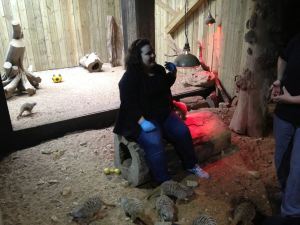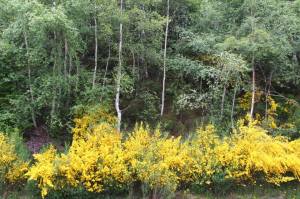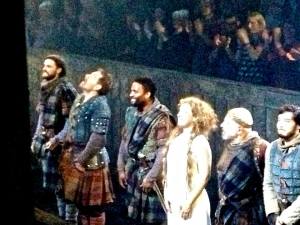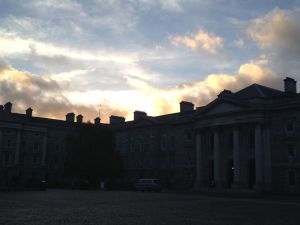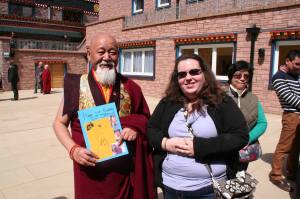I spent four days at Kagyu Samye Ling, a Tibetan center and monastery. I will go more in detail about my actual experience there but first I wanted to post about the different elements of the center itself. It is the first Tibetan Buddhist Center in the West, built in 1967, nestled in the hills of Scotland and is the most peaceful place I have ever been. As I am still learning about these different elements, I got all of this information from the Samye Ling website.

These stupas line both sides of the entrance to Samye Ling next to the Butterlamp House. When the Buddha died and passed into parinirvana (final liberation), his disciples cremated his body and interred his ashes in eight stupas, which were erected in different auspicious locations. Each stupa represents an important event in the life of the Buddha.
The Dorms and Dinning Room

The Dorms…

On the way to the Dinning Hall

The Butterlamp House

Where they light 1,000 butterlamps for world peace.
The Peace Garden


This is a statue of Nagarjuna, the forefather of the Madyamika school of philosophy, which forms the basis of the Karma Kagyu view of emptiness. According to Buddhist legend, Nagarjuna discovered the Prajnaparamita teachings that had been entrusted to the nagas for safekeeping.

The king cobra rising up behind Nagarjuna is the king of the nagas and is protecting him from rain and sunshine. This is reminiscent of an older story of the Buddha wherein once when the Buddha was practicing meditation, it began to rain and a king cobra rose up behind him and used its head to shield him from the rain and fierce elements.
The statue conveys several different symbolic meanings. All snakes and fish are seen as symbolic of nagas; so Nagarjuna is located in a lake filled with fish and is protected by a cobra. He is seated on the coiled body of the snake, whose body acts as a parasol, to show that the nagas are respectful of him and wish to serve him. The books to his left are the Prajnaparamita Sutras. The vase to his right is a vessel for storing his monastic possessions. According to the accounts of his life, he kept his monastic vows perfectly. Consequently, he is also wearing the robes of a fully ordained monk. The hand gesture or “mudra” is the mudra of teaching. It indicates that he is instructing the nagas in the Dharma (the teachings of the Buddha.) His legs are in the bodhisattva posture, which is symbolic of his love and concern for all living beings.
The Cloutie Tree

It is both a Scottish and Tibetan custom to make a wish and then tie a coloured ribbon to the tree. As the cloth fades the wish is carried off by the elements and hopefully one day comes true.
The Stupa

A Stupa is a symbol of the enlightened mind of the Buddha and its function is to restore, balance and transform negative energies to heal both our planet and ourselves. The form and contents of the Stupa express the balance and purification of earth, water, fire, air and space. They also express the wisdom and compassion of Buddha nature, the true nature of all living beings. The Victory Stupa at Samye Ling was consecrated in 2000 and is the first of its kind in Scotland.

The Prayer Wheels around the Stupa

The prayer wheels contain millions of mantras (short prayers) for peace and compassion, which have been inscribed on paper soaked in saffron water and blessed in a special way. As one turns the prayer wheel clockwise it activates the blessing of the mantras, transmitting the energy of peace and compassion in all directions.

The Temple

Pictures cannot do this place justice.

In the centre of the balcony above the entrance to the main shrine is a large golden eight-spoked Dharma wheel. This represents the wheel offered to the Buddha by the god Brahma so that he would teach the Dharma after he attained enlightenment. The two deer alongside the wheel represent the two deer that emerged from the forest at Deer Park and sat down next to the Buddha when he began to teach the Four Noble Truths for the very first time, showing that his teachings are relevant to all beings, not just humans.

On the four corners of the gold roof, there are chusins or water animals whose function is to harmonize the water element.
Inside the Temple

There are 16 Karmapa statues representing each of the 16 incarnations of the Karmapa, who is head of the Karma Kagyu lineage of Tibetan Buddhism. These statues are at the front of the shrine on the top row. Each statue contains relics (such as pieces of their robes, nails and hair) from that specific Karmapa. Placed in square cabinets around the central statue of the Buddha are smaller statues of the main lineage holders (arranged clockwise from left to right): Dorje Chang, Tilopa, Naropa, Marpa, Milarepa and Gampopa.
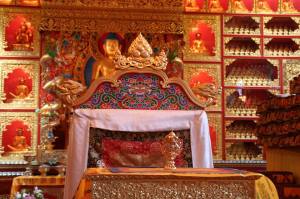
Where Akong Rinpoche sits during the ceremonies

In Tibetan a shrine room is called Lhakang, which means ‘Palace of the God’. This indicates that representations of enlightened beings are present.
In a Buddhist shrine three things are essential…1. Relics or images of the historical Buddha. These are not for worship. Instead, the statues, relics and images are to provide inspiration for what we can achieve by following the Buddha’s teachings. They also serve as a support for our respect and devotion to the teachings.

The main Buddha statue was not made in Samye Ling, but was imported from India. Inside the statue is a ‘life stick’, which represents the inner spiritual life force. The statue also contains relics, dried flowers and precious jewels. The statue is particularly precious because it contains relics of both the Buddha and Guru Rinpoche. They are behind the diamond on the forehead of the Buddha statue.
It is believed that anyone who looks on the statue will find peace of mind and his or her karma will be purified.
Beside the main statue are two standing figures depicting the Arhats Shariputta and Amogollana, the Buddha’s two main disciples. Around the statue itself are the Twelve Deeds of the Buddha shown in pictorial form. They represent the main events in the Buddha’s life. The dragons are symbols of bodhisattvas offering wish-fulfilling jewels to the Buddha.

2. Representations of the Sangha or followers of the Buddhist Teachings. The Sangha is represented in the shrine by the 1000 Buddha statues at the front and by the statues of the Kagyu lineage on either side of the main Buddha statue. The 1000 Buddhas represent all the Buddhas that will appear in this cosmic aeon and each of these statues contains a precious relic.

3. Representations of the Dharma (or Teachings). At the time of the historical Buddha there was no image of him and his teachings were not written down. Two of his main disciples, who had committed his teachings to memory, later wrote them down. These writings are referred to as the Kanjur. At a later stage commentaries were written on these teachings by enlightened scholars and are called the Tanjur. Referred to as ‘the Buddhist Canon’, these appear in the shrine room as the scrolls covered in gold and red cloth on either side of the main shrine. Those covered with gold cloth are the Tanjur and those covered in red cloth are the Kanjur.

On the ceiling of the shrine are alternating screen prints of dragons and phoenixes, painted in Chinese style. The phoenix balances yin (male) and yang (female) energies. In Tibet dragons are revered because they are regarded as having magical and healing powers. Both of these animals have the symbolic function of prolonging life. The Sanskrit letters written on the cross beams inside the shrine are the names of different Buddhas in the past and are also purification mantras which bless all those who walk beneath it.

Inside the Temple. Where we prayed, conducted the Green and White Tara Initiation Ceremonies, and took class – those are our desks
The Gardens and The River
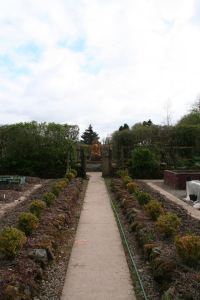
The Organic Garden, where they members of Samye Ling grow their own food.



Garden Pets…



The River Esk

This stone structure is embedded with semi-precious stones and was built as an offering to the nagas or water spirits who dwell at the junction between the two rivers.

Making offerings to nagas is a way of bringing environmental forces into balance. The point where the two rivers meet is directly opposite the doors of the temple and is very powerful in terms of geomancy. The Naga House also serves a function in balancing the powerful energies emanating from this point.

Medicine Tara Statue

The Tara Healing Garden is dedicated to the 21 emanations of Tara and will preserve and propagate medicinal herbs native to Tibet that can be cultivated in the climate of the Scottish Borders. Each of the 21 emanations of Tara has the power and the qualities to overcome 21 different kinds of physical and mental disease. Therefore 21 different herbs connected with these different aspects will be planted in separate petal shaped beds around the central statue of Medicine Tara.

“Fairy Hill”

The flags are inscribed with prayers for peace, compassion, strength and wisdom; and the different colours represent the five natural elements. They are flown with the aspiration that as the wind blows, the blessing of the prayers will be carried in all directions.

Formal Entrance to Samye Ling

This is the formal entrance to Kagyu Samye Ling. The Gate is dedicated to world peace and is decorated with carved mantras and figures that are said to help develop peace of mind in all those who see it or go under it.




The Karma Kagyu tradition is the spiritual lineage of Samye Ling. At the bottom of the pillars are paintings of four great kings who are guardians of the four directions and ward off negative forces

On the inside of the pillars further down, are other animals carved into the sides of the pillars, all of whom have a protective function in warding off negative influences. You can see a white yak,

a white hawk

and a black scorpion, all of which are different manifestations of Nyenchen Tangla, a mythical king

The black crow symbolizes Mahakala, the principal protector within the Karma Kagyu tradition of Tibetan Buddhism. A protector is a manifestation of enlightened energy that wards off and transforms obstacles and negative conditions. There are black crows ALL OVER St. Andrews, so learning this brings a whole new meaning to my life in my small university town.
It is a beautiful place, where everything has a lot of meaning.
